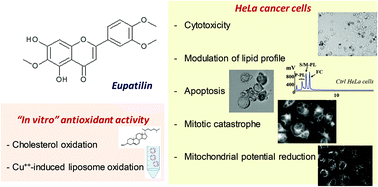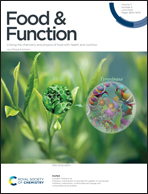The dietary flavonoid eupatilin attenuates in vitro lipid peroxidation and targets lipid profile in cancer HeLa cells
Abstract
Eupatilin is a dietary flavonoid isolated from the alpine wormwoods, used for the genepy liqueur production. This flavone protects cells and tissues against oxidative stress and targets cancer cells, inducing cytotoxicity, cell circle arrest, apoptosis and mitochondrial dysfunction. This study examines the EUP in vitro antioxidant effects on cholesterol and phospholipid membrane oxidation and explores its ability to modulate the cancer cell lipid profile. This flavone remarkably protected fatty acids and cholesterol against oxidative degradation by scavenging lipoperoxyl radicals. EUP (24 h of incubation) significantly reduced viability and modulated the total lipid and fatty acid profiles in cancer HeLa cells. It induced marked changes in the phospholipid/cholesterol ratio, significant decreases in the levels of oleic and palmitic acids and a marked increase of stearic acid, involving an inhibitory effect on de novo lipogenesis and desaturation in cancer cells. Moreover, a noteworthy mitochondrial membrane depolarization, signs of apoptosis, abnormal mitosis with multi-nucleation (mitotic catastrophe) and morphological alterations were observed in cancer EUP-treated cells. Our results validate the EUP role as antioxidant agent for the treatment/prevention of disorders implicating a membrane lipid oxidative damage and substantiate cell lipid metabolism as another possible target of this dietary natural flavonoid in cancer HeLa cells.



 Please wait while we load your content...
Please wait while we load your content...